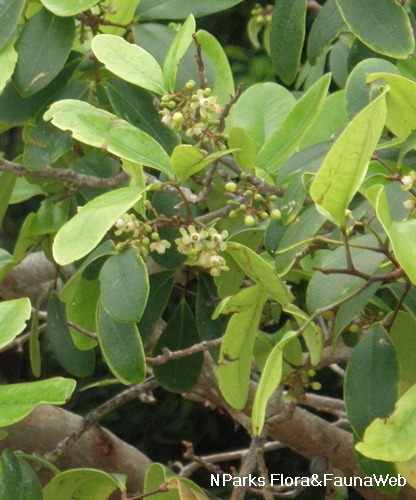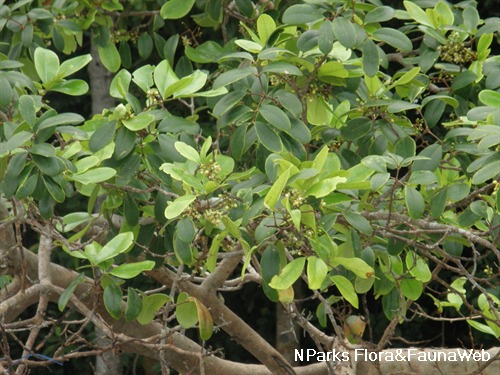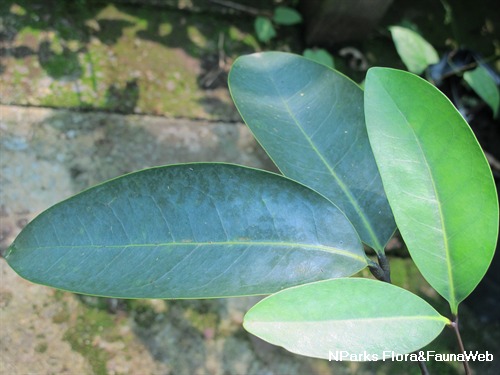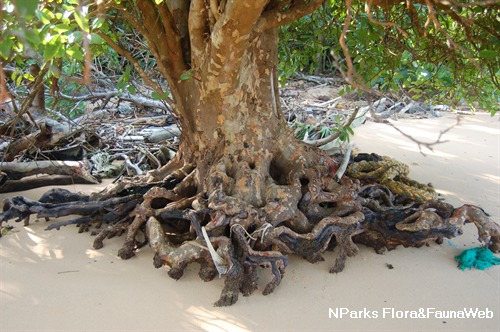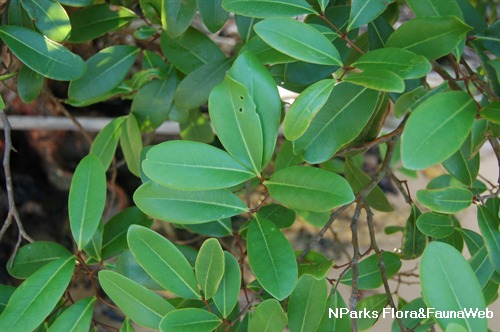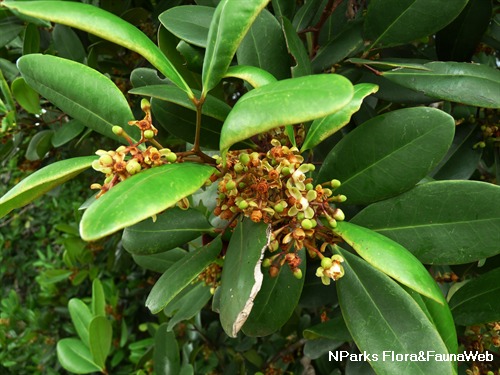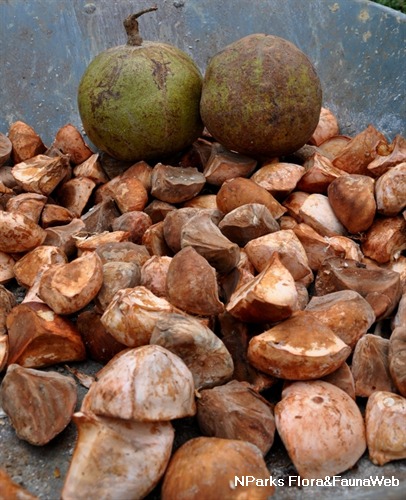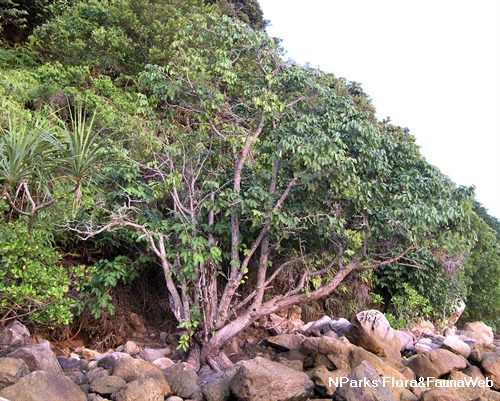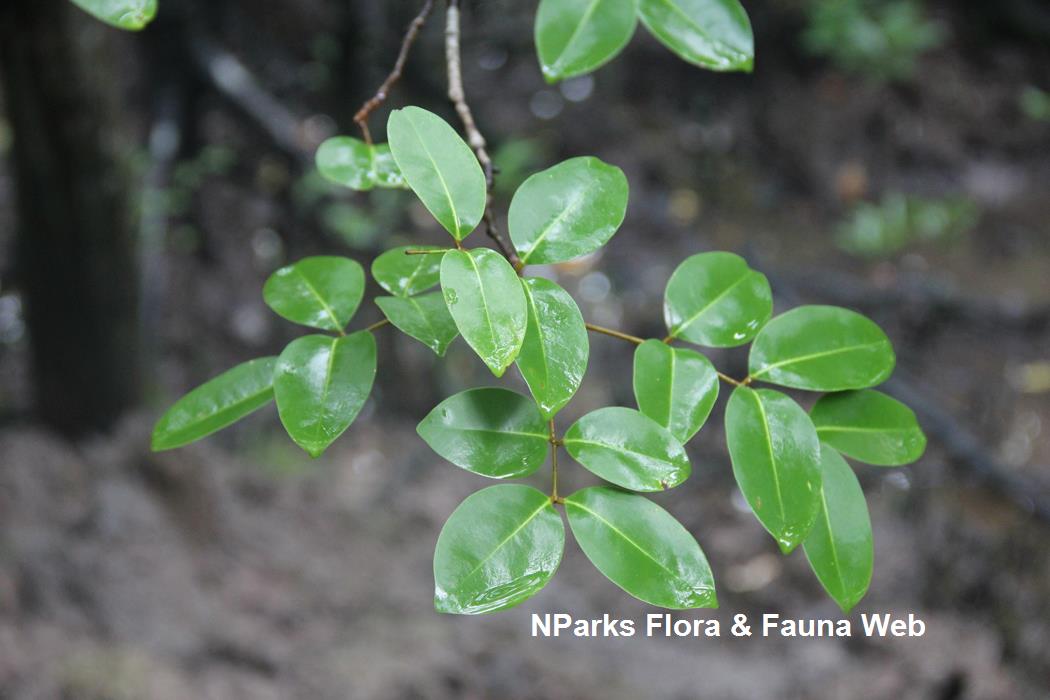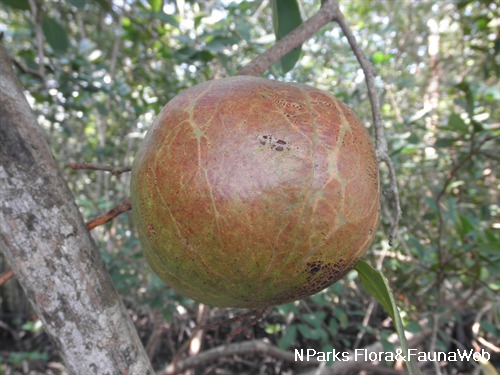
Back
Xylocarpus granatum J.Koenig
| Family Name: | Meliaceae |
| Common Name: | Nyireh Bunga, Mangrove Cannonball Tree, Cannonball Mangrove, Nyirih, Nyirih Hudang, 木果楝 |
Name
Classifications and Characteristics
| Plant Division | Angiosperms (Flowering Seed Plants) (Dicotyledon) |
|---|---|
| Plant Growth Form | Tree (Medium (16m-30m), Shrubby (1m-5m)) |
| Lifespan (in Singapore) | Perennial |
| Mode of Nutrition | Autotrophic |
| Plant Shape | Irregular |
| Maximum Height | 3 m to 20 m |
Biogeography
| Native Distribution | From East Africa to tropical Asia, Papua New Guinea, and the Pacific Islands |
|---|---|
| Native Habitat | Shoreline (Mangrove Forest) |
| Preferred Climate Zone | Tropical |
| Local Conservation Status | Native to Singapore (Least Concern (LC)) |
Description and Ethnobotany
| Growth Form | It is a tree up to 20 m tall, with long buttresses that snake laterally. Its smooth bark is light brown, yellowish or greenish, and flaky. |
|---|---|
| Trunk | Trunk produces grey flaking bark with light brown to orange patches. |
| Roots | Mature individuals produce long, spreading buttress roots which are usually not observed in young individuals. |
| Foliage | Its alternate, stalked, pinnate leaves consist of up to 3 pairs of leaflets. The stalked leaflets have leathery leaf blades that are usually narrowly drop-shaped or oval, 3.5–12 by 2–6 cm, with rounded tips. |
| Flowers | Its often forked flowering shoot is up to 7.6 cm long, and develops from the leaf axils, with indistinct main axis. Many clusters of up to 3 fragrant flowers are found on the shoot. Its flowers have creamy-white or pinkish petals. Flowers are fragrant. |
| Fruit | Its brown fruits are woody capsules, and grapefruit- to small pomelo-sized. The ripe fruits split into four parts from the apex to reveal up to 20 seeds each. Its brown seed is up to 6 cm long with a corky seed coat. |
| Habitat | It usually grows in estuarine mangrove forests. It occurs locally at the end of Lim Chu Kang Road, in Khatib Bongsu, Punggol area, Sungei Pandan, Pulau Ubin, and Pulau Tekong. |
| Associated Fauna | Its flowers are insect-pollinated. |
| Cultivation | It can be propagated by seed. |
| Etymology | Greek xylon, wood; Greek karpos, fruit, referring to the woody fruits; Latin granatum, full of seeds |
| Ethnobotanical Uses | Medicinal: In Malaysian traditional medicine, the roots are used to treat cholera and dysentery. Timber & Products: The wood was once used to make boats. The wood is available as short pieces of timber. The timber is used in boat building and other purposes. Others: This species has phytoremediation potential, because it accumulates manganese, zinc, boron, iron and copper. The bark contains tannin, so used for dying cloths, tanning leather, toughening and preserving fishing nets. Hair oil can be made using oil extracted from the seeds. |
Landscaping Features
| Landscaping | The plant can tolerate brackish water, so may be suitable for planting in coastal areas. |
|---|---|
| Desirable Plant Features | Ornamental Fruits, Fragrant |
| Landscape Uses | Coastal, Beachfront / Shoreline, Phytoremediation (Ground / Water Contaminant(s)) |
Fauna, Pollination and Dispersal
| Fauna Pollination Dispersal Associated Fauna | Butterfly Host Plant (Leaves) |
|---|---|
| Pollination Method(s) | Biotic (Fauna) |
| Seed or Spore Dispersal | Abiotic |
Plant Care and Propagation
| Light Preference | Full Sun |
|---|---|
| Water Preference | Lots of Water |
| Plant Growth Rate | Moderate |
| Rootzone Tolerance | Moist Soils, Waterlogged Soils (Drains Site, Does not Drain Site) |
| Maintenance Requirements | Moderate |
| Pest(s) | Chewing Insects |
| Propagation Method | Seed |
Foliar
| Foliage Retention | Evergreen |
|---|---|
| Mature Foliage Colour(s) | Green |
| Mature Foliage Texture(s) | Smooth |
| Foliar Type | Compound (Even-Pinnate) |
| Foliar Arrangement Along Stem | Opposite |
| Foliar Attachment to Stem | Petiolate |
| Foliar Shape(s) | Non-Palm Foliage (Obovate, Oval) |
| Foliar Venation | Pinnate / Net |
| Foliar Margin | Entire |
| Foliar Apex - Tip | Rounded |
| Foliar Base | Acute |
| Typical Foliar Area | Notophyll ( 20.25cm2 - 45 cm2 ) |
| Leaf Area Index (LAI) for Green Plot Ratio | 3.0 (Tree - Intermediate Canopy) |
Floral (Angiosperm)
| Flower & Plant Sexuality | Bisexual Flowers |
| Flower Colour(s) | White |
|---|---|
| Flower Texture(s) | Smooth |
| Flower Grouping | Cluster / Inflorescence |
| Flower Location | Axillary |
| Flower Symmetry | Radial |
| Individual Flower Shape | Cruciform / Cross-shaped |
| Flowering Habit | Polycarpic |
| Flower Size | 0.8 cm |
Fruit, Seed and Spore
| Mature Fruit Colour(s) | Brown |
|---|---|
| Mature Fruit Texture(s) | Smooth |
| Fruit Classification | Simple Fruit |
| Fruit Type | |
| Mature Seed Colour(s) | Cream / Off-White |
| Mature Seed Texture(s) | Smooth |
| Seed Quantity Per Fruit | Few (1-5) |
References
| References | Yong J, Tan PY, Nor Hafiz Hassan, Tan SN. 2010. A Selection of Plants for Greening of Waterways and Waterbodies in the Tropics. Singapore: Chung Printing . 480 pp. |
|---|
Image Repository
Others
| Master ID | 30527 |
|---|---|
| Species ID | 4836 |
| Flora Disclaimer | The information in this website has been compiled from reliable sources, such as reference works on medicinal plants. It is not a substitute for medical advice or treatment and NParks does not purport to provide any medical advice. Readers should always consult his/her physician before using or consuming a plant for medicinal purposes. |

